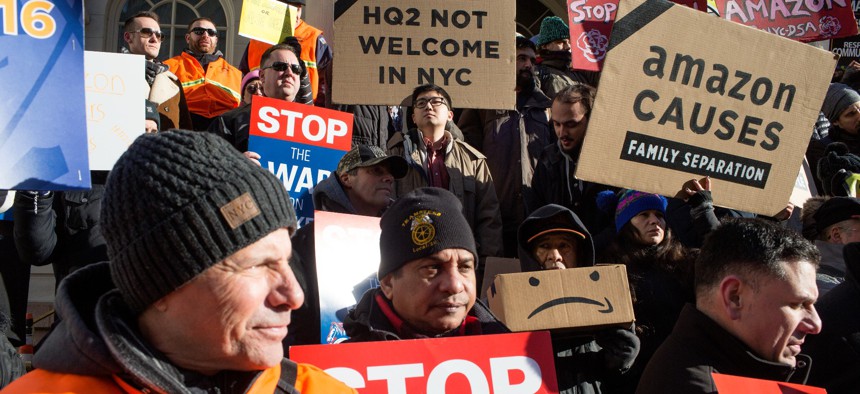How State and Local Leaders Can Address America’s Wealth Gap

Residents of a Queens working-class neighborhood in New York City protest against Amazon’s proposed second headquarters in 2018. Andrew Lichtenstein/Corbis via Getty Images
COMMENTARY | The traditional method of offering incentives to corporations to help generate economic development in distressed areas has failed. It’s time to embrace a more people-centric approach called community wealth building.
One clear message for state and local governments from the results of the 2022 midterm elections is that they shouldn’t look to Washington for bold policies to address the nation’s chronic economic problems. Instead, split control of a polarized Congress means outside-the-box approaches to problems rooted in racial inequity, income disparity and the climate crisis will have to come from local communities.
More community leaders are realizing they will need a new set of tools to tackle these entrenched, serious problems. Based on what’s happening around the world and here at home, community wealth building must be a part of their toolkit.
Community wealth building focuses on giving people greater control of the economic activities that affect their daily lives through shared ownership of economic assets. The idea was first articulated by our organization, The Democracy Collaborative, in 2005. It stands in contrast to traditional economic development approaches that depend on giving incentives to large corporations and institutions to invest in communities in hopes that their presence will create positive spinoff effects for the local economy.
This traditional economic development approach is falling out of favor in the very communities that proponents argue would benefit the most—areas of high unemployment and chronic disinvestment. Examples of this changing attitude include the 2018 protests from a Queens working-class neighborhood in New York City against Amazon’s proposed second headquarters, and current opposition to subsidizing a stadium for the Washington Commanders football team in Washington, D.C.
The reason for the shift? Growing recognition that for many—especially Black and Brown people—benefits at the top are not trickling down to them. Millions find themselves instead on a treadmill, working harder and longer in precarious jobs for less pay, with their income outpaced by the skyrocketing cost of living and growing debt. Without bold policies to stimulate a structural reset of the economy, this extraction and concentration of wealth will continue to turn institutions created to serve and protect all of us into guarantors of wealth for the few, disenfranchising tens of millions, undermining democracy and imbedding division for generations to come. Indeed, the American dream will be, as it is already for many, a distant, unattainable fantasy.
To seriously address wealth inequality, lawmakers need to think on an entirely different scale. It cannot be solved by tinkering around the edges. New federal programs like the Inflation Reduction Act and the American Rescue Plan Act are huge opportunities to give individuals and communities a leg up. But we need to rewire our economy entirely, so that it works for all people, the planet, and future generations. In other words, we need to democratize our economy.
That’s why it’s exciting to see a growing cohort of community leaders focusing on how a community’s existing wealth and resources can be better recirculated and multiplied. There are cities around the world replicating the community wealth building model first launched by the Evergreen Cooperatives in the late 2000s in Cleveland, Ohio. The city of Preston in the United Kingdom, for example, just celebrated 10 years creating a viable economy after adopting the initial model.
In the United States, cities ranging from Chicago to Meadville, Pennsylvania, are exploring the policy and infrastructure support needed to scale and supercharge community wealth building. Working in partnership with communities, these local governments are investing in worker cooperatives and municipal enterprises. They’re using their purchasing power to buy needed goods from community-owned social enterprises and local women- and minority-owned businesses. They are bringing local land and real estate back under community control and into creative forms of productive use through asset transfers and community land trusts. They are also looking to establish public banks that direct public financial assets to community financial institutions that invest in the Main Street economy.
Local governments are the laboratories of democracy and where we should be looking for solutions. This is no time for business as usual. Americans want and need change. Without it, deepening hardship will worsen the country’s toxic divides and fractious politics. If state and local government officials do not make radical moves to address the rampant and destabilizing wealth inequality that has now become a defining feature of life in America, our democracy will remain at risk.
Community wealth building offers a real playbook of concrete actions that can be taken right now to attack the crises of wealth inequality and racial inequity at their roots. At a time of stalemated government in Washington, it also offers a way to inspire new confidence in democracy by bringing democracy to the economy and providing all of us with a real path to the American dream.
Sarah McKinley is director of community wealth building programs, and Isaiah J. Poole communications consultant at The Democracy Collaborative.
NEXT STORY: What the $1.7 Trillion Spending Bill Includes for States and Localities





